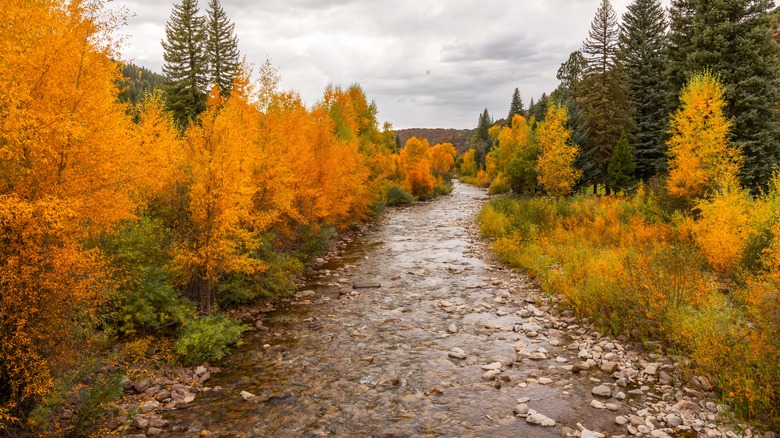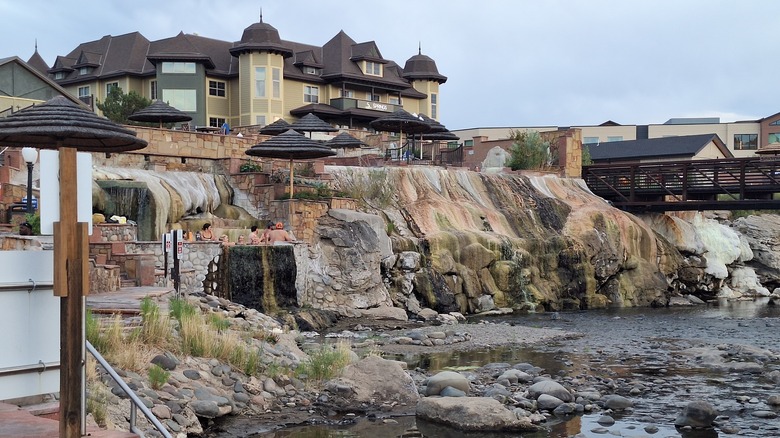What Colorado's Unprecedented Floods Mean For Your Vacation Plans
Located along the picturesque San Juan River about 300 miles southwest of Denver, Pagosa Springs, Colorado, is home to one of the best natural hot springs resorts in America: The Springs Resort & Spa. It holds the Guinness World Record for the deepest geothermal hot spring aquifer in the world and boasts around 50 soaking pools, along with waterfalls, cold plunges, and a steam grotto, all accessible 24/7. That makes it a popular vacation stop for travelers seeking relaxation on their out-west getaways, or a worthy detour along a scenic San Juan Scenic Byway mountain road trip.
But all that beautiful water has its risks: Beginning October 11, 2025, Pagosa Springs was hit hard by back-to-back tropical storm remnants — Priscilla and Raymond — which dumped torrential rain over the American Southwest, and southwestern Colorado's La Plata and Archuleta counties – where The Springs is located — were especially hard hit. On October 12, an emergency declaration was issued after the San Juan River surged past its banks. Mandatory evacuations were ordered in parts of the area, and by October 13, The Springs' staff were sandbagging pools and infrastructure in hopes of mitigating flooding.
The flooding reached historically high levels, with the San Juan River rising from just over 4 feet to over 12 feet in about 30 hours — the highest in more than 50 years. As it rose, the flood dislodged a tree that struck a sewer pipe attached to the First Street Bridge, causing untreated sewage to spill into the river as waters overtopped their banks. As a result, authorities closed Highway 160 between Highway 84 and Hot Springs Boulevard for several days. Although it has reopened to vehicles, pedestrian walkways and local parks remain closed as cleanup and repair efforts continue.
The Springs Resort is open and ready for 'soaking season'
Despite the damage, no fatalities have been reported, and water levels have since receded. At The Springs Resort & Spa, video footage showed umbrellas and chairs submerged, but after the rain subsided, only about 20% of its pools had to be drained and cleaned — the rest remained open. Affected guests were offered upgraded amenities and access as compensation, and some even reported enjoying the experience. "The videos look a lot worse than the actual realities we're dealing with right now," said the resort's Vice President of Marketing Jesse Hensle, per The Denver Gazette. "There's an energy and excitement," he added. "People are sitting above the river in a safe atmosphere and just watching Mother Nature put on this show ... While sitting in a hot spring pool." September and October are popularly known as "soaking season," because you can admire fall colors from the pools. While some visitors preemptively canceled upcoming reservations, the resort remains fully open and actively restoring all pools to normal operation.
The severity of the flooding was amplified by the region's prolonged drought conditions, according to the U.S. Drought Monitor. Dry, compacted soil absorbs sudden moisture poorly, leading to rapid runoff, flash flooding, and increased risk of rock and mudslides. The extreme weather underscores the fragility of local infrastructure, especially in places unaccustomed to such precipitation levels. Nearby Durango, a quintessential western town located about 60 miles west of Pagosa Springs, was also hit hard, particularly near Vallecito Lake, a hidden gem typically known for its tranquil shoreline. But its proximity to water made it vulnerable to flooding. "This was absolutely unprecedented flows," said a spokeswoman for La Plata County, according to KOB 4. "I don't think anybody has seen this amount of water going down Vallecito Creek."

